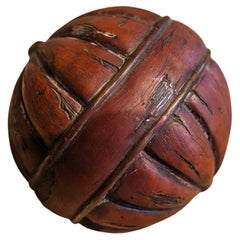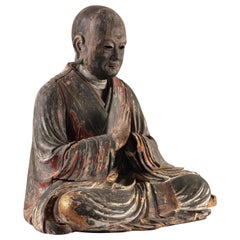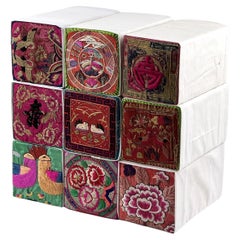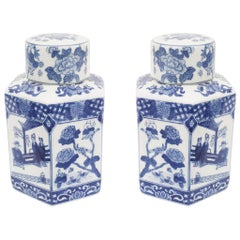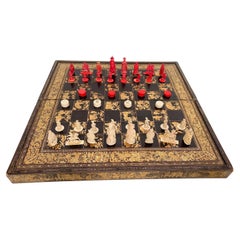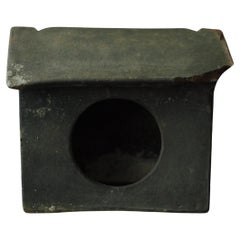East Asian Antiquities
to
340
562
285
1,321
14
5
4
3
2
2
1
1
1
1
474
408
439
19
229
45
59
23
3
9
3
3
5
7
6
15
2
553
313
287
243
156
1,885
1,340
735
403
377
1,340
1,337
1,337
10
3
3
2
1
Place of Origin: East Asian
Japanese Sphere Toy, Japan, Wabi Sabi, 20th Century / Japanese object
Located in Edogawa-ku Tokyo, JP
A charming antique Japanese wooden ball toy, hand-carved with a striking radial design. Crafted from richly toned wood with beautifully aged patina, it embodies both the simplicity a...
Category
Early 20th Century East Asian Antiquities
Materials
Wood
Japanese Kamakura/Muromachi Period Cedarwood Buddhist Priest, 12th-15th Century
Located in Amsterdam, NL
Seated Buddhist priest
Japan, Kamakura period (1185-1333) or Muromachi period (1333-1573).
Different carved hollow blocks of cedar wood joined togeth...
Category
15th Century and Earlier Antique East Asian Antiquities
Materials
Cedar
Nine Sqare Auspicious Korean Traditional Embroidered Pillows
Located in seoul, KR
These traditional Korean embroidered pillows, often included in a bride's dowry during the modern era, symbolize auspicious blessings for a harmonious and prosperous married life. Fe...
Category
19th Century Antique East Asian Antiquities
Materials
Fabric
$1,950 Sale Price
35% Off
Pair of Chinese Blue/White Porcelain Ginger Jars
Located in Queens, NY
PAIR of Asian Chinese (20th Century) blue and white porcelain temple / ginger jars with round lids, and hexagonal bases, featuring figures and a floral pattern (PRICED AS PAIR)
Category
20th Century Chinese Export East Asian Antiquities
Materials
Porcelain
$1,500 / set
19th Century Rare Large Chinese Gilt Lacquer Gaming Board Box with Chesses
Located in Brea, CA
19th Century rare large 25'' Chinese export gilt decorated black lacquer gaming board box, finely decorated with gold on a black background of characters, f...
Category
19th Century Qing Antique East Asian Antiquities
Materials
Lacquer
Japanese Antique Ceramic Zushi "KAWARA-ZUSHI" 1920-1930s/Object Wabi-sabi Mingei
Located in Iwate-gun Shizukuishi-cho, Iwate Prefecture
An early tiled shrine"KAWARA-ZUSHI".
Ceramic shrines were made in pottery producing areas all over the country, but they are rare, and are only made in Okayama today.
It is thought ...
Category
Early 20th Century Showa East Asian Antiquities
Materials
Ceramic
18th/19th Century Bronze Tibetan Altar Piece - 8629
Located in Ukiah, CA
Beautiful 18th/19th century bronze Tibetan Altar Piece. I've not seen one like this before. Very sweet well cast elephant on top, with a copper bridle. T...
Category
Late 18th Century Antique East Asian Antiquities
Materials
Bronze
$1,875 Sale Price
50% Off
A Molded Longquan Celadon 'Fu Shou' Ewer, Ming Dynasty
Located in seoul, KR
One side of the vase showcases a panel with the Shou character at its center, symbolizing longevity, while the opposite side displays the Fu character, signifying luck. The neck of the vase is adorned with leaves. There are similar types and decoration but varying in shape, resembling a pear, all from the same era and crafted in celadon, often referred to as 'fu shou' vases.
Period: Yuan-Ming Dynasty (1271-1644)
Region: Longquan, China
Medium: Celadon
Type: Ewer
Provenance : Acquired in late 1990s from Hongkong
Reference
1) British Museum - Museum number 1931,1118.5
(Type : Closely related)
2) Christies NEW YORK 24–25 MAR 2022 - Important Chinese Ceramics and Works of Art - Lot 1105
(Price realised : 9,450 USD / Type : Related)
3) Sotheby's New York 19 March 2024 - Chinese Art - Lot 172
(Price range : 15,000 USD - 20,000 USD / Type : Related)
* Ming Dynasty Longquan Celadon
Longquan celadon from the Ming Dynasty typically exhibits a more robust and heavier stoneware body compared to its Song Dynasty predecessors. The Ming era saw an evolution in celadon glaze, achieving a wider spectrum of green hues, from olive to bluish-greens. Ming celadons...
Category
15th Century and Earlier Ming Antique East Asian Antiquities
Materials
Celadon
$1,995 Sale Price
50% Off
Pair of 19th Century Chinese Official's Hat Chairs
Located in Kastrup, DK
19th century Chinese Official chair.
Elmwood, original red and black lacquer.
Back splat with vague remains of decorations (natural wear and tea...
Category
Mid-19th Century Qing Antique East Asian Antiquities
Materials
Elm
A Han Dynasty Terracotta Figure
Located in Chicago, IL
A large Chinese terracotta tomb figure (Ni Yong) from the Eastern Han Dynasty (25-220 AD), likely from the area of modern-day Sichuan. It appears to depict a groom in full costume an...
Category
15th Century and Earlier Antique East Asian Antiquities
Materials
Terracotta
$12,600 Sale Price
30% Off
China 549-577 AD Northern Qi Dynasty Ancient Caparisoned Horse In Earthenware
Located in Miami, FL
Exceedingly rare Chinese pottery caparisoned horse from the Northern Qi region.
A beautiful sculptural piece, created in China during the Northern Qi dynasty period, between the 549 and 577 AD. This horse statue is extremely finely modeled of earthenware pottery, standing in a very elegant and majestic position striding on a trapezoidal shaped base.
The animal has a gracefully arched neck to the left and its extremely well modeled. The head is adorned with a large detailed tassels of plumes and the body is embellished with a beautiful saddle and intricate harnesses. The trapping around the chest and rump is adorned with elaborated tassels and the straps are accented with multiples florets and bosses in high relief.
The surface is treated with applications of natural pigments such; red, white and others.
Has a measurements of 394 mm by 343 mm by 257 mm (15.53 x 13.52 x 10.15 Inches) (39.4 x 34.3 x 25.7 Cm).
Northern Qi, was the successor state of the Chinese Xianbei state of Eastern Wei...
Category
15th Century and Earlier Archaistic Antique East Asian Antiquities
Materials
Earthenware, Pottery
$31,988 Sale Price
20% Off
19th Century Pair of Chinese Carved Rosewood Flower Stands Marble-Top
Located in Brea, CA
19th century a pair of antique 31.5” large Chinese rosewood flower stands marble top insert, 2 pieces, the inset marble-top over carved rosewoo...
Category
Late 19th Century Chinese Export Antique East Asian Antiquities
Materials
Hardwood
Japanese Antique flower stand, Wabi-Sabi, Japandi
Located in Katori-Shi, 12
This elegant flower stand from Juri Sakura features a plant inlay on the top.
The delicate design and long, slender legs make this a striking piece.
The beauty of the details throug...
Category
Early 20th Century Taisho East Asian Antiquities
Materials
Wood
STUNNING SiGNED ANTIQUE CIRCA 1870 JAPANESE VASE DEPICTING A BIRD ON A BRANCH
Located in West Sussex, Pulborough
Royal House Antiques
Royal House Antiques is delighted to offer for sale this absolutely stunning circa 1870 signed to the base solid bronze Japanese bronze vase depicting a large b...
Category
1870s Japonisme Antique East Asian Antiquities
Materials
Bronze
Round red lacquered and gold leaf work box - China 19th Qing Dynasty
Located in Beuzevillette, FR
Magnificent round box in red lacquer in two parts.
Completely decorated by hand. With gilded, gold decoration.
There are floral and geometric decorations, handmade interlacing, with gold leaf.
The box is placed on 4 feet.
The interior is lacquered black.
Very nice dimensions.
This box shows some wear due to its age and authenticity.
This round Chinese box in red and gold lacquered woven bamboo Was probably a wedding box, a work box, a storage box.
It can be used as a hat box, sewing box, games box or tea bag box...
Category
19th Century Qing Antique East Asian Antiquities
Materials
Bamboo, Wood
A Copper-Red Ceramic Bowl with Auspicious Motifs, Ming-Early Qing Dynasty
Located in seoul, KR
A copper-red produced in Jingdezhen, China, during the Ming to early Qing dynasty (15th–17th century). It features a copper red applied over a bluish-white glaze, which is glaze type...
Category
16th Century Ming Antique East Asian Antiquities
Materials
Copper
$2,660 Sale Price
30% Off
Large Cast Iron Tub with Floral Motif
Located in Greenwich, CT
Large cast iron tub with floral motif with four ring pulls, there is one casted inscription on one side with date made : " Emperor Qianglong Era 32nd yea...
Category
Late 19th Century Qing Antique East Asian Antiquities
Materials
Iron
Chinese Pottery Camel, Northern Wei Dynasty (386 - 535 AD), China, TL Tested
Located in Austin, TX
A delightful and rare Chinese painted high fired gray pottery model of a wooly camel, Northern Wei Dynasty (386 - 535 AD), China, with TL test.
The charming camel is portrayed stand...
Category
15th Century and Earlier Antique East Asian Antiquities
Materials
Pottery
Two Yixing Zisha Teapots and Covers
Located in seoul, KR
Both Yixing Zisha teapots appear to be modern to republic-era pieces. Yixing Zisha teapots are made from rare Zisha (紫砂) clay, which is exclusively...
Category
20th Century East Asian Antiquities
Materials
Pottery
$975 Sale Price / set
35% Off
Antique Chinese Gilt Sterling Silver Cloisonne Phoenix
Located in Brea, CA
A antique unique incredible Chinese gilt sterling silver cloisonne phoenix on wood base, statue features beautiful emamel in blues, greens with jewel...
Category
Early 20th Century Chinese Export East Asian Antiquities
Materials
Silver
Meiji Era circa 1900 Antique Japanese Bronze Sea Dragon 3-Arm Candelabra
Located in Tustin, CA
Magnificent and powerful, fantastically sculptural, ferocious bronze Japanese writhing sea dragon candleholder is coiled around itself, with an uplifted head and a stylized plume of ...
Category
Late 19th Century Meiji Antique East Asian Antiquities
Materials
Bronze
Japanese Antique Ceramic Zushi "KAWARA-ZUSHI" 1920-1930s/Object Wabi-sabi Mingei
Located in Iwate-gun Shizukuishi-cho, Iwate Prefecture
Height 21cm, width 23.2cm, depth 16cm.
An early tiled shrine"KAWARA-ZUSHI".
Ceramic shrines were made in pottery producing areas all over the country, but they are rare, and are o...
Category
Early 20th Century Showa East Asian Antiquities
Materials
Ceramic
$640 Sale Price
20% Off
A Molded Qingbai 'Flowers' Dish, Southern Song Dynasty
Located in seoul, KR
The plate depicted here exhibits the intricate floral patterns and lotus motifs that are typical of Southern Song designs. The central floral motif captures the essence of Oriental b...
Category
15th Century and Earlier Antique East Asian Antiquities
Materials
Ceramic
$1,560 Sale Price
60% Off
Set of Five Chinese Sancai Female Attendant Figures
Located in Chicago, IL
Molded of earthenware, this set of five petite sculptures are a type of centuries-old burial figurine known as míngqì. Such model figures were placed in tombs of individuals with high status to ensure a safe journey to the afterlife. Meant to depict the pleasures of daily life, common burial figures...
Category
15th Century and Earlier Antique East Asian Antiquities
Materials
Ceramic
Antique Wooden Chest , Wabi Sabi, Japandi
Located in Katori-Shi, 12
This drawer shelf from the Taisho period combines Japanese style with modernity.
This drawer shelf is particularly elaborate among those made in the Taisho period, and the complexit...
Category
Early 20th Century Taisho East Asian Antiquities
Materials
Wood
Antique Chinese Ceramic Headrests 'Opium Pillow', Early 20th Century, Pair
Located in Jimbaran, Bali
This pair of Chinese ceramic headrests feature a green, brown and blue glaze as well as floral motifs. They also feature pierced sides with sy...
Category
Early 20th Century Qing East Asian Antiquities
Materials
Ceramic
Han Dynasty, Antique Chinese Pottery Bowl Support By Three Legs
Located in Sampantawong, TH
Chinese pottery bowl support by three legs.
Age: Chinese, Han Dynasty, B.C. 206 - A.D. 220
Size: Diameter 23.7 C.M. / Thickness 11.7 C.M.
Condition: Well-preserved old burial condit...
Category
15th Century and Earlier Antique East Asian Antiquities
Materials
Pottery
$880 Sale Price
20% Off
19th Century Antique Gilt Lacquer Chinese Tea Caddy
Located in Brea, CA
19th century golden black lacquer Chinese tea caddy with two pewters with 4 foots, the gilt body decorated with panels of landscapes, two pewters with covers, one pewter lead ring...
Category
Mid-19th Century Qing Antique East Asian Antiquities
Materials
Lacquer
Han Dynasty Gray Pottery Figure of a Female Kneeling Long Sleeve Dancer
Located in Austin, TX
A stunningly quiet and elegant Western Han dynasty (206 BCE - 9 CE) high fired gray pottery figure of a female long sleeved dancer.
The young dancer is portrayed in a moment of quie...
Category
15th Century and Earlier Han Antique East Asian Antiquities
Materials
Earthenware
Rare 19th Century Chinese Porcelain Brush Pot for Vietnam
Located in MEAUX, FR
Rare 19th Century Chinese Porcelain Brush Pot for Vietnam, Enhanced with 22k Gold Kintsugi Restoration
Immerse yourself in the history and elegance of this rare Chinese porcelain...
Category
19th Century Antique East Asian Antiquities
Materials
Porcelain
Early 20th Century, Showa, Japanese Bronze Vase
Located in Sampantawong, TH
Japanese bronze vase.
Age: Japan, Showa Period, early 20th century
Size: height 29.1 cm / width 16.3 cm.
Condition: nice condition overall.
Category
Early 20th Century East Asian Antiquities
Materials
Bronze
$1,000 Sale Price
20% Off
Antique 18th Century Export Chinese Lacquer Gaming Box
Located in Brea, CA
Antique 18th century export Chinese lacquer gaming box with hand painted scenes gilt export black lacquer, there are 7 gaming boxes and 12 trays, size: ...
Category
Late 18th Century Qing Antique East Asian Antiquities
Materials
Lacquer
19th Century, Meiji, Antique Japanese Iron Teapot with Bronze Lid
Located in Sampantawong, TH
Antique Japanese iron teapot with bronze lid.
Age: Japan, Meiji Period, 19th Century
Size: Height 19.8 C.M. / Width 17.3 C.M. / Diameter 15.5
Co...
Category
19th Century Antique East Asian Antiquities
Materials
Bronze, Iron
$1,000 Sale Price
20% Off
Stunning Terracotta Standing Horse, Tang Dynasty, China '618-907 AD', TL Test
Located in San Pedro Garza Garcia, Nuevo Leon
Magnificent standing horse in orange terracotta and traces of painting. With a finely decorated saddle and with the mane and tail hair braided. TL Test by Ralph Kotalla Lab NE: 09K12...
Category
15th Century and Earlier Tang Antique East Asian Antiquities
Materials
Terracotta
5/6thC Chinese Bronze Buddha - 9585
Located in Ukiah, CA
Amazing personality to this very early (pre-Tang) bronze Buddhist "angel" from a huge and elaborate back-plate from a Buddhist altar from 5th/6thC. The quality and face are superb. Close to 2 3/4 inches tall and 2 5/8 wide. 4 inches tall on custom stand. This and all the other parts would have each been individually cast and attached by loops (its loop is still there, being used to attach to stand) on back of angel to back-plate. This piece is small, but extremely rare, early, finely done, and loaded with personality. One of the rarest and most museum-worthy Chinese pieces...
Category
15th Century and Earlier Antique East Asian Antiquities
Materials
Bronze
$23,600 Sale Price
20% Off
EXQUISiTE ANTIQUE 18TH CENTURY CHINESE BUTTERFLY CINNABAR LACQUER BOWL & COVER
Located in West Sussex, Pulborough
Royal House Antiques
Royal House Antiques is delighted to offer for sale this rather exceptional Chinese cinnabar lacquer box and cover circa 18th century with a top depicting Butte...
Category
18th Century Chinese Export Antique East Asian Antiquities
Materials
Wood
Green-Glazed Dish, Han Dynasty
Located in seoul, KR
This Han Dynasty green-glazed dish exhibits significant signs of wear, indicative of its age and the long passage of time it has witnessed. The glaze, once vibrant, now shows substan...
Category
15th Century and Earlier Han Antique East Asian Antiquities
Materials
Earthenware
Chinese Ancient Hand Carved Unicorn
Located in South Burlington, VT
A Chinese hand carved and hand painted wooden effigy of an extraordinary unicorn dating to the Song dynasty before 1279 AD.
Please enjoy the beautiful remnants of its aged original ...
Category
15th Century and Earlier Antique East Asian Antiquities
Materials
Wood
Large Cocoon-shaped jar with cloud-scroll design, Han Dynasty
Located in seoul, KR
This jar would have served as a mortuary object (mingqi), placed in a tomb as a substitute for the more valuable bronze and lacquer vessels used in daily life. Along with a variety o...
Category
15th Century and Earlier Han Antique East Asian Antiquities
Materials
Pottery
$1,813 Sale Price
30% Off
Sancai-Glazed ‘Floral’ Dish, Liao Dynasty(916~1125)
Located in seoul, KR
Well potted with shallow sides rising from a short foot, the interior molded with a single chrysanthemum surrounded by peony blossoms picked out in amber and with green leaves agains...
Category
15th Century and Earlier Tang Antique East Asian Antiquities
Materials
Pottery, Stoneware
$3,835 Sale Price
35% Off
19th Century Antique Chinese Jadeite Brush Washer with Dragon
Located in Brea, CA
Antique 19th century Chinese jadeite brush washer, decorated in the from of dragon, external rim diameter 6cm, high 3cm. Inside 4cm x 2.5cm x 2cm, very...
Category
19th Century Qing Antique East Asian Antiquities
Materials
Jade
Large Pottery Standing Figure of Attendant, Han dynasty
Located in seoul, KR
This artwork, acquired in Hong Kong during the 1990s, is presumed to have been produced in the same kiln from the Han dynasty, based on the head of the Sotheby's reference piece, which also originated from Hong Kong. Furthermore, given its almost identical shape to the piece from the Artemis Gallery...
Category
15th Century and Earlier Han Antique East Asian Antiquities
Materials
Pottery
$3,213 Sale Price
30% Off
Very old Japanese teapot-shaped pottery "Koseto" / 1200s / Excavated pottery
Located in Sammu-shi, Chiba
This is Seto ware.
Seto is a kiln with a long history located in Aichi Prefecture, Japan (Seto kilns are marked with red circles on the map). It is said to have originated around the 13th century.
In Japan, items from this period of Seto ware are referred to as "Ko-Seto." "Ko" means "old."
This particular item is Ko-Seto, which was fired around the 13th century.
One of the distinguishing features of Ko-Seto, as compared to other kilns, is the presence of glaze. While other kilns produced mostly unglazed pottery, Ko-Seto was covered with ash glaze, giving it a yellowish-green or pale emerald-green color.
In the early Kamakura period (13th century), when Ko-Seto production began, there was increased demand from temples in Kamakura (the capital city of the time, in present-day Kanagawa Prefecture) and the Tokai region for roof tiles, Buddhist ritual objects, and burial urns...
Category
15th Century and Earlier Other Antique East Asian Antiquities
Materials
Pottery
Hirado Porcelain Koro Censer Meiji Dynasty
By Hirado
Located in Mérida, YU
This is an original Japanese Antique Porcelain Hirado Koro Censer circa 1850-1890 Meiji Dynasty.
In perfect condition.
Museum
Category
Late 19th Century Japonisme Antique East Asian Antiquities
Materials
Porcelain
Antique Small Chest of Drawers from 19th Century, Japan
Located in Tokyo, Tokyo
Antique small chest of drawers from Edo period (1603-1868), Japan.
Because of its age, the chest shows signs of use, which in turn make...
Category
19th Century Antique East Asian Antiquities
Materials
Iron
Japanese Antique Table, Early 20th Century
Located in Katori-Shi, 12
This cafe table has attractive legs that form a unique curve.
The bow-like curves, lavishly carved from high-quality ash wood, are both cute and elegant.
Another attractive feature ...
Category
Early 20th Century Taisho East Asian Antiquities
Materials
Wood
Japanese antique earthenware/Wabi-sabi objects/Unglazed pottery
Located in Sammu-shi, Chiba
I would like to introduce some earthenware with a very interesting shape.
This is an old excavated earthenware from Japan, called "Yayoi" or "Hajiki".
This item is from before the 9...
Category
15th Century and Earlier Other Antique East Asian Antiquities
Materials
Pottery
A Large Straw Glazed Pottery Figure of a Solider, Sui to Tang Dynasty
Located in seoul, KR
This well-modeled ceramic figure depicts a Scythian warrior in full armor, likely serving as a standard bearer. The warrior stands upright on a thin rectangular base, with clenched f...
Category
15th Century and Earlier Tang Antique East Asian Antiquities
Materials
Straw
$1,275 Sale Price
25% Off
Earthenware Ewer, Yi
Located in seoul, KR
This terracotta vessel was fired to a warm yellow-brown that shows subtle oxidation marks across the surface. Entirely unglazed, it retains a matte, tactile finish with fine pores an...
Category
15th Century and Earlier Antique East Asian Antiquities
Materials
Earthenware, Pottery
$1,300 Sale Price
35% Off
Japanese Katakuch Wood bowl / Mingei Wabisabi
Located in Sammu-shi, Chiba
If you are looking for something special, we recommend buying items selected by BROOD.
We sell a carefully selected range of old Japanese items.
We have seen tens of thousands of ite...
Category
Mid-20th Century Showa East Asian Antiquities
Materials
Wood
Two Yixing Teapots and Covers
Located in seoul, KR
Both Yixing Zisha teapots appear to be modern-Republic era pieces. Yixing Zisha teapots are made from rare Zisha (紫砂) clay, which is exclusively mi...
Category
20th Century East Asian Antiquities
Materials
Pottery
$975 Sale Price / set
35% Off
Archaic Jade Pendant, China, Early 20th Century
Located in Roma, IT
This amazing Archaic Jade pendant, was realized in China in the early 20th century.
In very good condition, except for signs of aging.
Provenance: I...
Category
Early 20th Century East Asian Antiquities
Materials
Jade
$652 Sale Price
30% Off
Chinese Carved white jade disc with openwork decoration on a wooden base, Qing
Located in Bilzen, BE
Antique 19th century Chinese disc carved in white jade on its original carved wooden base.
Qing period
In very good condition, diameter of the jade 5.5 ...
Category
19th Century Qing Antique East Asian Antiquities
Materials
Jade
Porcelain with transparent pale-bluish (qingbai-type) glaze, Yuan Dynasty
Located in seoul, KR
This piece is shaped like a lotus bud, featuring a gracefully undulating body and intricate geometric patterns. The neck is adorned with finely incised dense lines, adding visual var...
Category
15th Century and Earlier Antique East Asian Antiquities
Materials
Ceramic, Porcelain
$1,225 Sale Price
30% Off
A Grey Pottery Figure of Boar(Wild Pig), Han Dynasty
Located in seoul, KR
This piece is an ancient terracotta animal sculpture in the form of a pig, rendered in a simple yet vivid manner. The pig stands firmly on four stout legs, with a short and solidly m...
Category
15th Century and Earlier Han Antique East Asian Antiquities
Materials
Pottery
$2,700 Sale Price
40% Off
13/14thC Large Thickly Cast Iron Korean Buddha, 9020
Located in Ukiah, CA
Very rare large thickly cast iron Korean Buddha (a magnet sticks to it). In an extremely early backless style. I believe this piece could be as late as 1...
Category
15th Century and Earlier Antique East Asian Antiquities
Materials
Iron
$10,075 Sale Price
35% Off
Celadon Vase, Five Dynasties or Northern Song dynasty, 10th-11th Century
Located in seoul, KR
The form of Longquan celadon vases from the Northern Song dynasty evolved from an early design with a long neck and tapering body to a later ovoid body with a shorter neck. Over time, the glaze developed a more olive tone, and the carved decorations became more pronounced and intricate. Examples of such vases include one without a cover dated to the Yuanfeng era (1078~1085) and documented in literature, and another similar vase without loop handles preserved by the Qingyuan County Cultural Relics Bureau. An earlier example featuring loop handles and a lotus-like cover is also mentioned in historical texts.
The use of Longquan covered vases, especially as funerary jars for offerings like wine and grains, was highlighted by an inscription on a piece from the Sir Percival David Collection, London. This inscription wishes for the vessel to preserve fragrant wine for centuries, blessing the owner with prosperity, longevity, and a vast lineage, dated to the third year of the Yuanfeng period (1080). This practice was common in the regions of Southern Zhejiang and Northern Fujian. A similar celadon vase from the Linyushanren collection was auctioned at Christie’s Hong Kong, emphasizing the cultural and historical significance of these artifacts.
Period : Five Dynasties or Northern Song Dynasty
Type : Celadon, Zhejiang province
Medium : Celadon
Size : 31.5 cm(Height) x 11.5(Diameter)
Provenance : Acquired in late 1990s from Hongkong
Reference :
1) The British Museum image id - 01613270570
2) Christies New York 23–24 MAR 2023 - Important Chinese Ceramics and Works of Art - Lot 1012
(Price Range : USD 18,000 – USD 25,000 / Type : Related)
3) National Gallery of Victoria - Accession Number - AS5-1973
* Celadon from Five Dynasties (907~960) to the early Northern Song Dynasty (960~1127)
The period from the Five Dynasties (907~960) to the early Northern Song Dynasty (960~1127) marked a significant transitional phase in the development of Chinese celadon ceramics...
Category
15th Century and Earlier Antique East Asian Antiquities
Materials
Celadon
$3,960 Sale Price
60% Off
Chinese Dian Culture Large Gold Cuff, circa 2nd Century BC, Southern China
Located in Austin, TX
A large and impressive solid high karat gold cuff from the Dian Kingdom, circa 2nd century BC, modern day Yunnan Province, China.
.
This striking cuff is crafted from hand hammered ...
Category
15th Century and Earlier Han Antique East Asian Antiquities
Materials
Gold
A Japanese netsuke depicting a monkey with a turtle
Located in Milano, IT
Boxwood netsuke depicting a seated monkey stopping a turtle with its right paw.
Period: Edo 19th century
Dimensions: 4 x 3.2 x 3.8 cm.
Condition: Excellent condition.
Category
19th Century Japonisme Antique East Asian Antiquities
Materials
Boxwood
$2,028 Sale Price
20% Off
A Japanese Samurai ressei menpo mask
Located in Milano, IT
Samurai menpo mask with the ressei (fierce) expression, belonging to the me-no-shita "half-face" type, which stands out for its leather surface to simulate ...
Category
18th Century Japonisme Antique East Asian Antiquities
Materials
Leather
$4,434 Sale Price
20% Off
Recently Viewed
View AllMore Ways To Browse
Large Chinese Celadon Pots
Khmer Torso
Ancient Luristan Bronze
Chinese Terracotta Army Warriors
Cloisonne Pots Bonsai Trees
Greco Bactrian
Han Dynasty Amphora
Han Dynasty Court Lady
Palanquin Handles
Sancai Phoenix
Schist Gandharan Buddha
Bactrian Stone
Chinese Coconut Cup
Han Dynasty Chinese Cocoon Jar
Han Dynasty Cocoon Jars
Han Dynasty Pig
Khmer Goddess
Kojima Shoten
